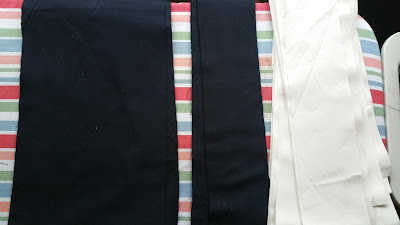This is one of my favourite quilt patterns, mostly because it's actually very easy but looks very impressive. The whole thing can be strip pieced on a machine quickly (comparatively speaking!) and easily (also comparatively speaking!). It is a quilt that could at a push be completed in a weekend - that is of course a hypothetical weekend with no interruptions, no mistakes and pre-prepared meals - so a holiday basically!
This is a very old irish pattern traditionally used as a wedding gift, the two chains representing the happy couple and their life together. Apparently it's the oldest known quilt pattern.
I recently took a trip to Ireland and visited the awesome Ulster Folk & Transport Museum. I happened to take a picture of this exact design which is on display inside one of the historic buildings at the museum. It was amazing not just to see these quilts but to actually touch them. Most of the one's I examined were hand pieced and hand quilted! I find it fascinating to think of the lives these ladies had, the hardships they suffered and the work they invested into pieces like this.
During the Irish Potato Famine a huge percentage of the Irish population emigrated to America, taking their patchwork designs and techniques with them. Initially all cloth had to be imported to America so it was very expensive. Necessity being the mother of invention, patchwork became hugely popular amongst the immigrants and it still is to this day.
It is in America that strip piecing became popular, especially after sewing machines became commonly availible. It is much, much faster than traditional English Paper Piecing.
As with any quilt I started with the colour scheme. I totally cheat and wait for the wedding invitation to arrive. I just take the colours the couple have chosen and use those. This way I can garuntee they like the colour choice and it also makes a nice reminder of their day.
So for this quilt it was white and navy. They're a practical couple so a mostly white quilt wouldn't be the best idea, besides I had oodles of this rather fine woven navy in just the right shade. Originally I was going to use plain white for the accent colour but I didn't have enough so a trip to my local fabric shop was needed.
This rather stunning Poplin Mini Leaves Fabric caught my eye. It looks plain white at first glance but when you look closely there is a subtle vine pattern over the fabric. It looks really classy, just a little bit of a pattern without being remotely fussy or girly.
Gorgeous isn't it.
With any big project I start my planning on paper, here's my scribbled notes from my Bullet Journal.
In the top left you can just about make out I've sketched the two block patterns. One is made up of 5 rows of 5 squares alternating navy and white (in this case - I could have used different colour combinations). The other panel is a large rectangle in the centre and a strip of navy with a white square at either end on each side.
I decided I wanted the squares to be 6cm square with a 1cm seam allowance. So each square should be cut to 8cm square.
Instead of cutting a gazillion 8cm squares I cut long strips of fabric 8cm wide.
The large rectangle is 18cm wide (6cm x 3 squares) plus 2cm seam allowance makes 20cm wide. So there's also a strip of navy 20cm wide on the left of the picture above.
I guess-timated quantities and made sure I had enough fabric to cut more if needed. In fact I deliberately underestimated so as to avoid wasting fabric.
Then I sewed a white strip onto each side of the wide navy strips.
Pressed.
And cut them to the right width which is 8 cm, the width of one block including seam allowance.
Here's my pile of strips.
Then I took my 20 cm wide length of navy fabric and stitched the strips onto each side of the wider strip.
Press again and cut them to width. These are the full size blocks which are 32cm wide (5 blocks x 6cm plus 2cm seam allowance).
Now this is where strip piecing really comes into it's own!
Those 5 x 5 blocks are made up of simple strips sewn speedily in bulk. The one pictured here is white - navy - white - navy - white. There was also navy - white - navy - white - navy.
After pressing each of these strips was cut to width - 8cm.
It looks like I neglected to take pictures the next part was so simple.
I sewed all the little blocks together in sets of 5 rows ensuring that the white and navy squares alternated.
More pressing.
I stitched each 5 x5 black onto the other block with the large rectangle.
Then stitched those together.
Then stitched those together.
Then stitched those together.
I kept laying out the quilt blocks as I went along checking everything was in the right place.
It came together amazingly quickly after I'd sewn and cut all those little blocks.
I'm so impressed with the stark contrast of the navy and white. It's not often I crafters can say this, but it looks just like it did in my mind.
I had originally planned to do the border in white with a much wider navy border around that but I'd ran out of fabric. I was "in the zone" and a snow storm prevented me from getting back to Minerva for more white. So I just improvised with what I had and went with a navy border instead.
So here it is, definitely my best quilt top yet.
The sandwich and quilting is a whole other story so I'm saving that for another blog post.









